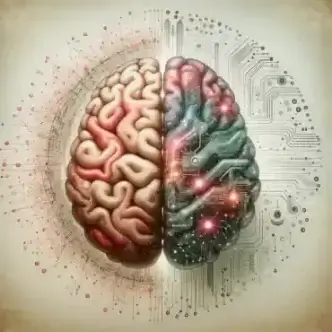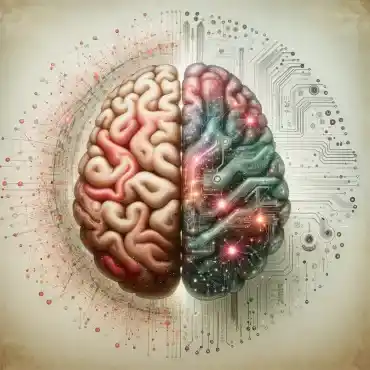In the field of neurobiology, a captivating story is unfolding, one that intertwines the intricate principles of Hebbian Dynamics, neuronal connectivity, and self-organizing models with the future of technology. This exploration not only offers insights into the human brain’s complex mechanisms but also paves the way for revolutionary advancements in technology. As we embark on this journey, let’s delve deeper into each of these concepts to understand their significance and potential impact.
Hebbian Dynamics: Deciphering the Brain’s Learning and Memory Mechanisms
Hebbian Dynamics, a fundamental concept in neurobiology, was introduced by Donald Hebb in the 1940s and has since become instrumental in our understanding of how the brain learns and retains information. Hebb’s rule, encapsulated in the maxim “cells that fire together, wire together,” provides a foundational understanding of synaptic plasticity – the brain’s ability to modify the strength of synaptic connections in response to experience.
This principle is central to the concept of associative learning, where the simultaneous activation of neurons leads to a strengthening of the connections between them. In a more detailed sense, Hebbian Dynamics suggests that if neuron A repeatedly contributes to the firing of neuron B, the synaptic link from A to B is strengthened. This synaptic strengthening is thought to occur through various biological mechanisms, such as the increase in neurotransmitter release at the synapse or the growth of new synaptic connections.
In practical terms, Hebbian Dynamics is seen in action when we learn new skills or information. For instance, learning to play a musical instrument involves the repeated activation of specific neural circuits coordinating motor skills, auditory feedback, and cognitive functions. Each practice session strengthens the synaptic connections within these circuits, making it easier to perform the skill over time.
This dynamic is not just limited to skill acquisition but is also vital in memory formation and retention. When we memorize new information, such as a name or a fact, the associated neural pathways are activated. Repeated activation through review or recall strengthens these pathways, thereby consolidating the memory.
Moreover, Hebbian Dynamics plays a critical role in early brain development. As a baby interacts with its environment, the sensory experiences drive the strengthening of certain neural connections while others are weakened or pruned away. This selective strengthening and pruning shape the developing brain, influencing cognitive functions and behavioral patterns.
Research in Hebbian Dynamics has also shed light on more complex neural processes, such as the formation of neural networks that underpin higher-order cognitive functions like problem-solving and abstract thinking. It has implications in understanding and treating neurological disorders where synaptic plasticity is affected, such as Alzheimer’s disease.
Additionally, Hebbian principles have been applied in the field of artificial intelligence, particularly in the design of neural networks. By mimicking the way neurons strengthen their connections, these networks can learn and adapt in a manner similar to the human brain, leading to more efficient and effective AI systems.
In summary, Hebbian Dynamics offers a window into the brain’s intricate learning and memory processes. It underscores the adaptability of the neural network in response to experiences, and its understanding remains crucial for advancements in neuroscience, psychology, and artificial intelligence.
Neuronal Connectivity: Mapping the Brain’s Complex Network
Neuronal connectivity, a fundamental aspect of the brain’s architecture, refers to how neurons, the brain’s primary information processors, interact with each other. These interactions occur at synapses, specialized junctions where neurons communicate. The human brain, a marvel of biological engineering, is comprised of approximately 86 billion neurons. Each neuron, with its dendrites and axon, can form synaptic connections with thousands of other neurons, leading to a staggeringly complex network with trillions of synapses.
This network’s complexity is not merely static; it’s dynamic and responsive. The synapses, which can be thought of as the communication channels between neurons, are capable of changing their strength and efficacy. This process, known as synaptic plasticity, allows the brain to adapt and reorganize itself in response to new information, sensory experiences, and learning processes. Synaptic plasticity is the biological foundation of the brain’s ability to learn and remember.
Hebbian Dynamics is integral to this process. It’s a principle that governs how synaptic connections are strengthened or weakened. According to this principle, if two neurons are repeatedly active at the same time, the connection between them strengthens. Conversely, if two neurons rarely or never fire together, their connection weakens. This principle is often encapsulated in the phrase “neurons that fire together, wire together.”
This dynamic shaping of the synaptic network is crucial for various cognitive processes. For example, in learning a new skill, the repeated activation of specific neural pathways strengthens the connections along these pathways, making the skill easier to perform over time. Similarly, in memory formation, the patterns of synaptic connections reflect the information being encoded, stored, and retrieved.
The adaptive quality of neuronal connectivity is not only essential for individual learning and memory but also for the overall functioning of the brain. It allows the brain to efficiently process vast amounts of information, adapt to changing environments, and recover from injuries. Moreover, the brain’s ability to rewire itself, known as neuroplasticity, underlies our capacity to develop new cognitive abilities and recover lost functions.
Understanding the intricate details of neuronal connectivity and its role in synaptic plasticity continues to be a key area of research in neuroscience. This knowledge has significant implications, not only for understanding the human brain but also for developing advanced computational models and treatment strategies for neurological disorders. The exploration of this complex network remains one of the most fascinating and challenging frontiers in modern science.
Self-Organizing Models: Mimicking the Brain’s Efficiency
Self-organizing models in technology are a groundbreaking innovation inspired by one of nature’s most complex systems – the human brain. These models, pivotal in the realms of artificial intelligence (AI) and machine learning (ML), emulate the brain’s remarkable ability to adapt, learn, and restructure itself without the need for explicit external programming.
In the brain, learning and adaptation occur through changes in synaptic connections, a process driven by experiences and interactions with the environment. Self-organizing models in AI and ML attempt to replicate this by designing systems that can autonomously adapt their internal structure and function in response to incoming data. This approach marks a significant shift from traditional programming paradigms, where changes to system behavior typically require human intervention or explicit reprogramming.
Neural networks, a subset of AI, are the epitome of self-organizing models. These networks consist of layers of interconnected nodes, or “neurons,” which mimic the neuronal structure of the human brain. In a neural network, each connection between nodes has an associated weight, analogous to the strength of a synaptic connection in the brain. These weights are adjusted as the network processes data, enabling the system to learn and make decisions based on its inputs.
The self-organizing nature of neural networks is evident in their ability to dynamically adjust their internal structures – particularly the weights of connections – in response to new information. This feature allows neural networks to excel in tasks such as pattern recognition, predictive modeling, and decision-making. For example, in speech recognition, a neural network can learn to identify and interpret various speech patterns by adjusting its internal connections based on audio input. Similarly, in predictive analytics, these networks can analyze large datasets to identify trends and make forecasts, continually refining their predictions as they process more data.
The efficiency of self-organizing models lies in their ability to distill complex patterns and relationships within data, much like how the brain makes sense of the vast array of sensory inputs it receives. This capability enables applications across a wide spectrum, from automating mundane tasks to solving complex problems in fields such as finance, healthcare, and environmental science.
As research in this field progresses, the potential of self-organizing models continues to expand. Future advancements may include more sophisticated neural networks capable of handling increasingly complex tasks, systems that can self-repair and adapt to changing environments, and AI that can develop new learning strategies autonomously.
In essence, self-organizing models are not just a technological innovation; they represent a fundamental shift in how we approach problem-solving and decision-making in machines, drawing closer than ever to the efficiency, adaptability, and complexity of the human brain.
Applications in Future Technology: Pioneering New Frontiers
- Neuromorphic Computing: This emerging field aims to mimic the neural structure of the human brain to create more efficient computing systems. Neuromorphic chips, for example, use networks of artificial neurons and synapses to process information in a way that’s similar to biological brains, offering potential improvements in speed and energy efficiency compared to traditional computing architectures.
- Adaptive Networks: Future communication networks could dynamically adjust their configurations based on user behavior and environmental conditions. This adaptability, inspired by the brain’s ability to reconfigure its neural pathways, could lead to more efficient data flow, reduced latency, and improved network resilience.
- Enhanced AI Learning: AI systems incorporating Hebbian principles and self-organizing capabilities have the potential to evolve beyond the limitations of traditional programming. These systems can continuously improve and adapt, learning from new data and experiences in a way that mirrors human learning. This capability is particularly promising for complex tasks such as language translation, autonomous vehicle navigation, and personalized medicine.

Dawn of a Neural-Inspired Era
The exploration of Hebbian Dynamics, neuronal connectivity, and self-organizing models represents a significant milestone in our understanding of the brain and the development of advanced technology. By drawing inspiration from the brain’s unparalleled complexity and adaptability, we stand on the brink of a new era in technology. This convergence is set to unleash a wave of innovations that will not only emulate but also extend the capabilities of the human brain, marking a transformative phase in the way we interact with and benefit from technology. As we continue this exciting exploration, the insights gleaned from the human brain are sure to illuminate our path towards a more intelligent and adaptable technological future.
____________
Written by: JK PANDEY












